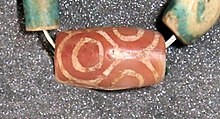Abydos, Egypt
In the ancient Egyptian language, the city was called Abedju (ꜣbḏw or AbDw)(Arabic Abdu عبد-و).
[3] These tombs began to be seen as extremely significant burials and in later times it became desirable to be buried in the area, leading to the growth of the town's importance as a cult site.
Most of Upper Egypt became unified under rulers from Abydos during the Naqada III period (3200–3000 BCE), at the expense of rival cities such as Nekhen.
[7] The conflicts leading to the supremacy of Abydos may appear on numerous reliefs of the Naqada II period, such as the Gebel el-Arak Knife, or the frieze of Tomb 100 at Hierakonpolis.
[6] Tombs and at least one temple of rulers of the Predynastic period have been found at Umm El Qa'ab including that of Narmer, dating to c. 3100 BCE.
Funerary enclosures, misinterpreted in modern times as great 'forts', were built on the desert behind the town by three kings of the Second Dynasty; the most complete is that of Khasekhemwy, the Shunet El Zebib.
Pepi I (Sixth Dynasty) constructed a funerary chapel which evolved over the years into the Great Temple of Osiris, the ruins of which still exist within the town enclosure.
[13] Ahmose II in the Twenty-sixth Dynasty rebuilt the temple again, and placed in it a large monolith shrine of red granite, finely wrought.
depth of the ruins discovered in modern times; these needed the closest examination to discriminate the various buildings, and were recorded by more than 4,000 measurements and 1,000 levellings.
The old temple entirely vanished in the Fourth Dynasty, and a smaller building was erected behind it, enclosing a wide hearth of black ashes.
Pottery models of offerings are found in these ashes and were probably the substitutes for live sacrifices decreed by Khufu (or Cheops) in his temple reforms.
[19] At an undetermined date, a great clearance of temple offerings had been made and the modern discovery of a chamber into which they were gathered yielded the fine ivory carvings and the glazed figures and tiles that demonstrate the splendid work of the First Dynasty.
A vase of Menes with purple hieroglyphs inlaid into a green glaze and tiles with relief figures are the most important pieces found.
[14] On 14 February 2021, Egyptian and American archaeologists discovered what could be the oldest brewery in the world dating from around 3100 BCE at the reign of King Narmer.
[14] A principal purpose of the temple was to serve as a memorial to king Seti I, as well as to show reverence for the early pharaohs, which is incorporated within as part of the "Rite of the Ancestors".
These included three chapels for the "state" deities Ptah, Re-Horakhty, and (centrally positioned) Amun and the challenge for the Abydos triad of Osiris, Isis and Horus.
Except for the list of pharaohs and a panegyric on Ramesses II, the subjects are not historical, but religious in nature, dedicated to the transformation of the king after his death.
Some of the hieroglyphs carved over an arch on the site have been interpreted in esoteric and "ufological" circles as depicting modern technology, having been the subject of pyramidology.
This carving was later filled in with plaster and re-carved during the reign of Ramesses II with the title "He who protects Egypt and overthrows the foreign countries".
Over time, the plaster has eroded away, leaving both inscriptions partially visible and creating a palimpsest-like effect of overlapping hieroglyphs.
[30][31] The adjacent temple of Ramesses II was much smaller and simpler in plan, but it had a fine historical series of scenes around the outside that lauded his achievements, of which the lower parts remain.
His list of pharaohs, similar to that of Seti I, formerly stood here; the fragments were removed by the French consul and sold to the British Museum.
Rows of small pits, tombs for the servants of the pharaoh, surrounded the royal chamber, many dozens of such burials being usual.
By the end of the Second Dynasty the type of tomb constructed changed to a long passage with chambers on either side, the royal burial being in the middle of the length.
[citation needed] The contents of the tombs have been nearly destroyed by successive plunderers; but enough remained to show that rich jewellery was placed on the mummies, a profusion of vases of hard and valuable stones from the royal table service stood about the body, the store-rooms were filled with great jars of wine, perfumed ointments, and other supplies, and tablets of ivory and of ebony were engraved with a record of the yearly annals of the reigns.











